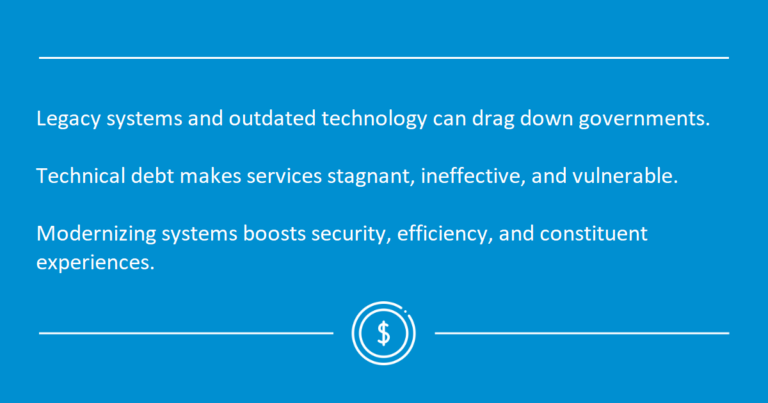
As an administrator responsible for effective operations and service delivery in your city or county, do you have a clear picture of technical debt and how critical it can be?
You know how challenging it can be to balance immediate needs with long-term goals when resources are tight.
This dilemma extends to the technology infrastructure meant to serve your community.
Technical debt refers to the backlog of unfinished tasks and unresolved issues accumulating in software and IT systems over time. It often stems from quick fixes, delayed upgrades, and resource constraints.
Like financial debt, technical debt accrues “interest” in extra maintenance costs, lost efficiency, and increased risk. This debt drag can profoundly impact service levels, productivity, security, and innovation if left unmanaged.

Technical debt may seem harmless at first. But over time, the accumulating interest payments can cripple progress. Examples of how it hinders city and county governments:
Unresolved debt ultimately leads to declining community services, unhappy constituents, increased risk, bloated IT costs, and frustrated employees.
Technical debt often gets overlooked amid pressing community issues. As an administrator, you must spotlight the problem and gains from addressing it using metrics tied to:
For example, communicating how debt paydown will reduce issue-resolution timeframes by 40% and allow reallocation of $200K annually from maintenance to growth initiatives.
Present how seamless systems can improve access to services and community participation. With clear ROI illustrated you gain support to prioritize technical debt.
Ignoring it only causes it to multiply, like credit card debt. As a leader, you must take focused steps to address it:
View technical debt paydown not as a cost but as an investment in improving services, driving efficiency, and accelerating innovation long-term.
Forward-thinking leaders recognize that proactive management of technology debt leads to:
Make this threat an advantage for your city/county by making it a consistent priority. The future success of your community may depend on it.
Technical debt is a lurking threat that can undermine service levels, increase risks, and restrain innovation. However, administrators who tackle it strategically can transform their technology into an asset for positive change.
With assessment, communication, and proactive management, technical debt can be handled like any other balance sheet liability. Pay it down through dedicated resources and diligent governance, and its drag will lift – making way for agile systems that help drive your city or county forward.
If you would like to learn more about technical debt, check out this full guide we created for leaders:
If you have more immediate concerns or needs, reach out, and we can do a full assessment of your current infrastructure.
Lorem ipsum dolor sit amet, consectetur adipiscing elit. Ut elit tellus, luctus nec ullamcorper mattis, pulvinar dapibus leo.

© 2024 Imagine IT Website by eMod, LLC